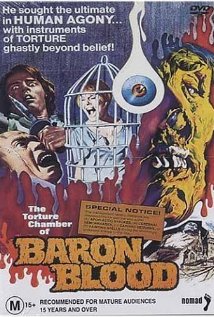Mario Bava’s BARON BLOOD is a fine a tribute to the monster movies of Hollywood’s golden age. So evocative of that period is this film that it takes not even a moment’s thought to mentally recast Boris Karloff as the Baron, Nan Grey as his intended victim and to tune away the vivid Technicolor into haunting black and white.
As in FRANKENSTIEN or THE MUMMY, the evil in the film is unwittingly unleashed upon the world by the film’s hero. In this case it is American Peter Kleist, who returns to the German castle of his ancestor Baron Otto Von Kleist. Even though he is aware that his ancestor, nicknamed “Baron Blood” was a sadistic monster who butchered and tortured the people of the countryside, Peter foolishly recites an ancient spell capable of resurrecting the Baron. The restored Von Kleist immediately resumes his homicidal ways, and now Peter, assisted by the beautiful Elke Sommer as a local historian, must find a way to undo what he has thoughtlessly wrought.
In the classic horror films of the 1930’s the monsters were iconic and unforgettable, while the heroes were bland and almost entirely irrelevant. After all, who remembers who played the “hero” opposite Lugosi in Dracula or Karloff in THE MUMMY? (For trivia’s sake it was David Manners in both films.) No, the villain/monster may have spent much of the picture lurking about off screen, or skulking in the shadows, but nevertheless he was always indisputably the star of the show.
BARON BLOOD maintains this link to its cinematic forbearers. Antonio Cantafora’s Peter Kleist is satisfactory, but eminently forgettable, while Joseph Cotton, obviously having a ball, is terrific in his villainous role. Cotton’s performance as the resurrected Von Kleist is spot on perfect, filled with evil charm and malevolent glee. He dominates the screen in the best tradition of the movie monsters of old.
In fact, there is only one significant departure from the classic monster films. Even in the days before the Hayes Commission, blood and gore were rarely seen and usually only suggested in Hollywood motion pictures. BARON BLOOD was produced without such restrictions and, though mild when compared to more recent horror films, it does contain some explicit moments that would have been completely unacceptable in the 1930’s. Even as a tribute to the grand old days, it must remembered that BARON BLOOD was produced to appeal to a contemporary 1970’s audience. Bava however realized that things modern will inevitably intrude upon the classic, and made light of this by placing soda pop machines in the halls of the Gothic Von Kleist castle and having prerecorded screams available in the Baron’s torture chamber at the flip of a switch.
Not as arty as LISA AND THE DEVIL, not as graphic as BAY OF BLOOD, BARON BLOOD is often unjustly overlooked, or simply dismissed as a minor effort of Mario Bava’s later period. Such hasty judgments do the film a great disservice. If BARON BLOOD has less of the striking cinematography of Bava’s best films, it must be argued that such innovation would be out of place in a film striving to recapture the look and atmosphere of the original Hollywood horror movies. If one accepts the movie for what it is, a fine tribute to the genre’s past, then BARON BLOOD is a great success, both as a homage and as work unto itself.
BARON BLOOD has been released in numerous VHS and laserdisc editions. The DVD release from Image Entertainment is probably the best example of the film currently available, featuring an uncut 1.85:1 widescreen presentation of the film, complete with the original European musical score, which was replaced when the film was released theatrically in North America.

